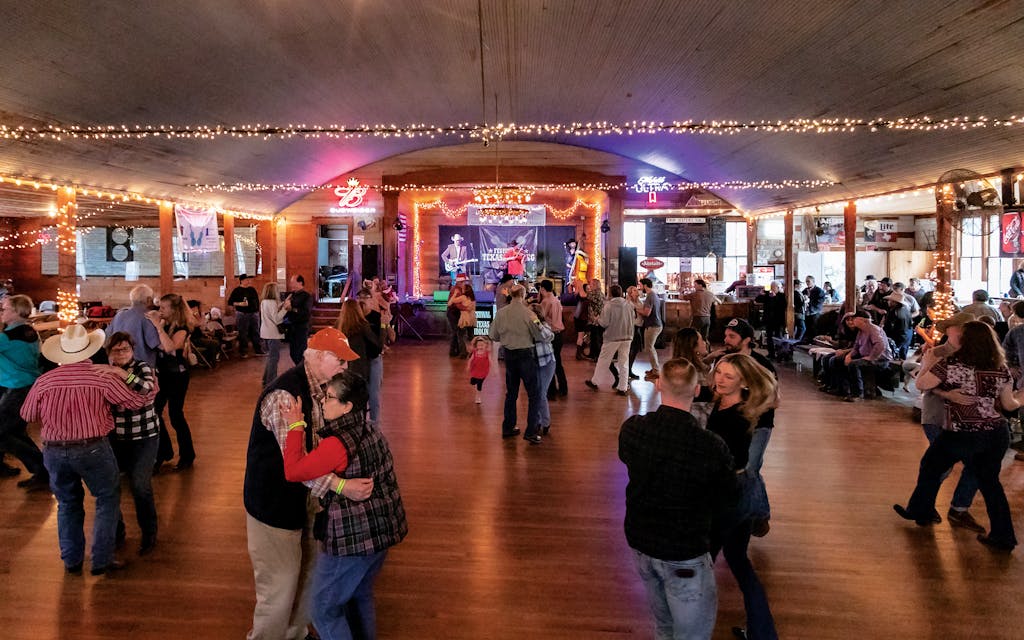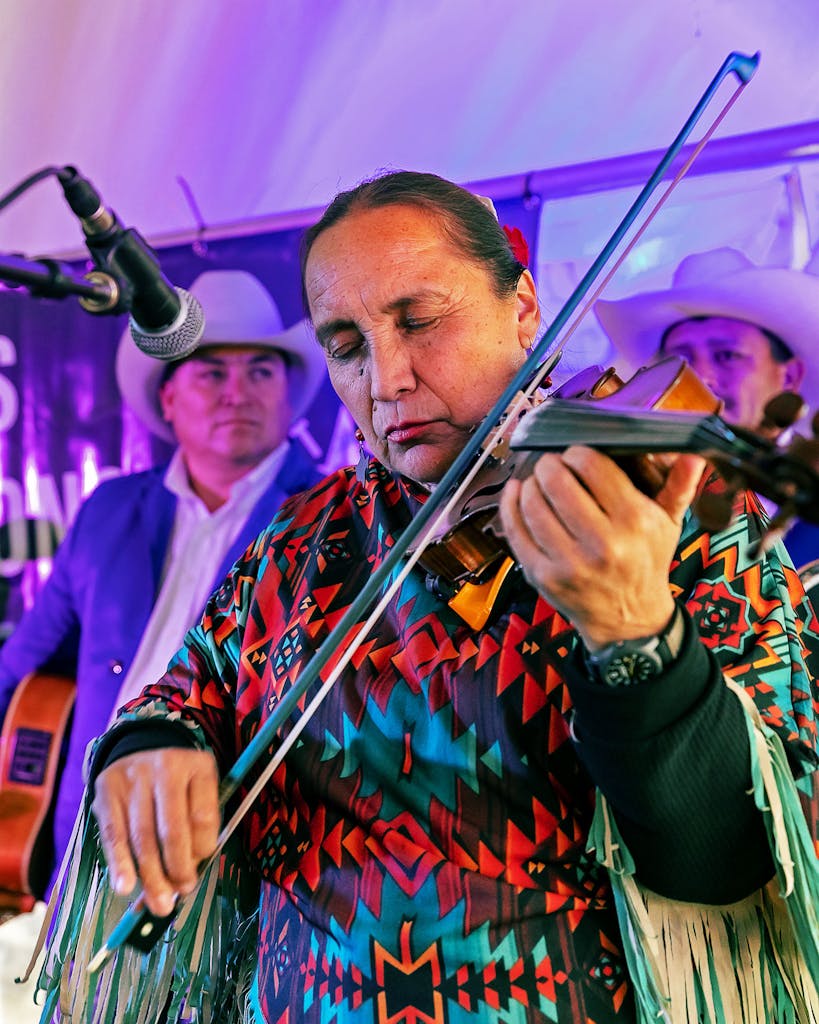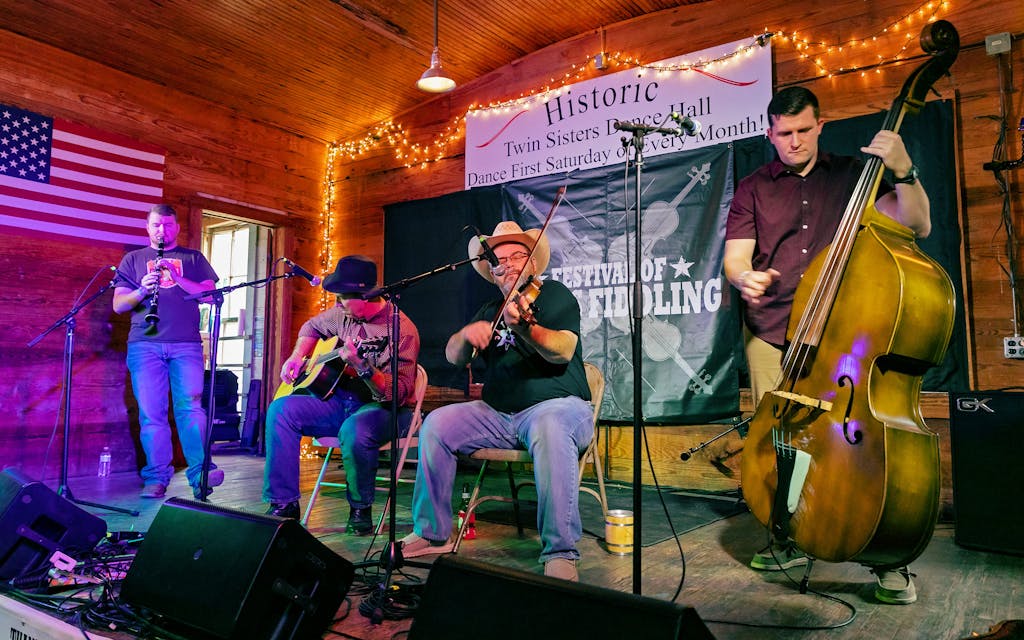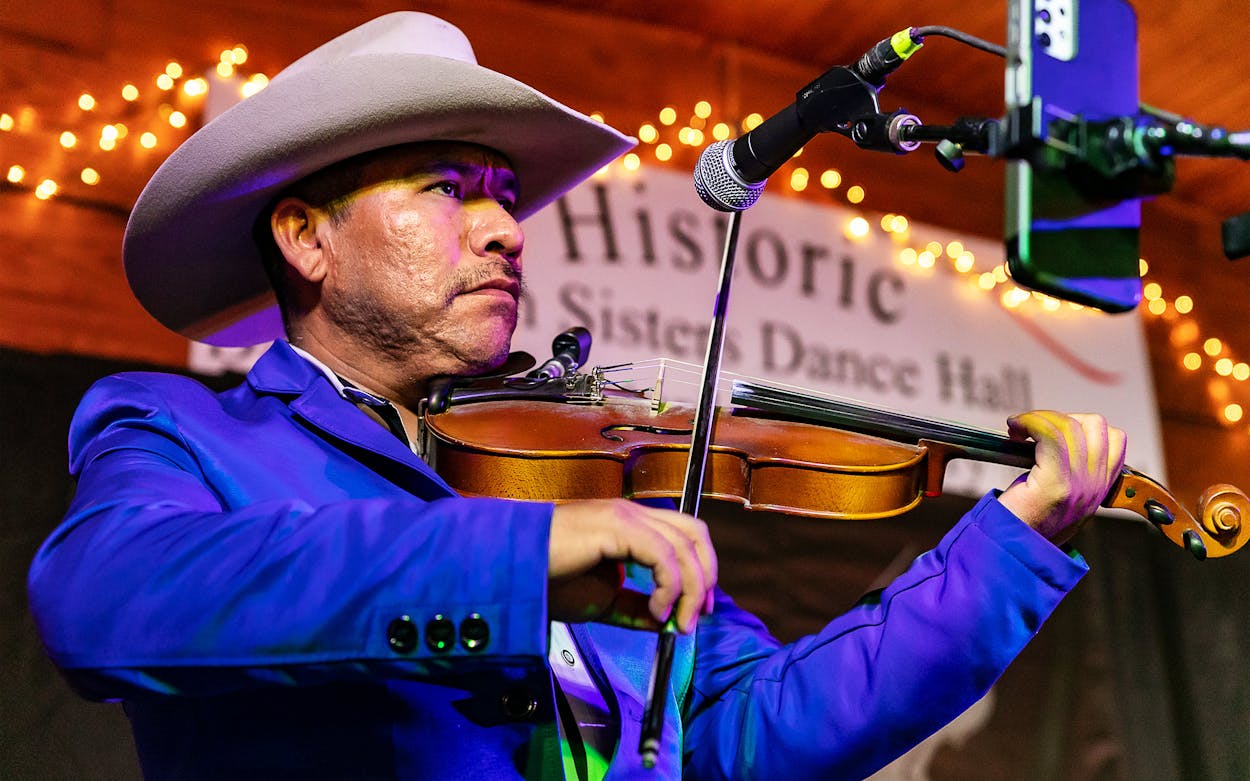While any fiddler in Texas can play “Faded Love,” the versions at the Festival of Texas Fiddling, in Blanco, might sound as different as an owl does from a rooster. The styles could be Gulf Coast, Creole, conjunto, Tejano, Zydeco, contest-style, son huasteco, Texas-Polish, Polish-Polish, old-timey, or Western swing. The fiddle could use a lot of double-stops, hitting two strings at once; it could hit staccato notes, it could embellish the melody in between verses, it could play the melody all the way through. And of course, “Faded Love” isn’t the only song the fiddlers milling around the two and a half acres surrounding the mid-1870s-era Twin Sisters Dance Hall would recognize, even if titles vary. A fiddler might call a tune one thing, and another player might call it something else.
“The Polish band playing right before us played a song that I swear was a song we play called ‘Devil in the Bayou,’ ” said bass player Christopher Smith Gonzalez, whose Galveston band, Kevin Anthony & G-Town, plays a style of country-Cajun Gulf Coast music. “So I went and talked to the fiddle player afterwards, and he was like, ‘Oh, that’s an old Polish song from who-knows-when.’ I was like, ‘Well, it’s exactly like the song from Harry Choates,’ this guy from the 1920s, 1930s, whose song we cover; he wrote a song called ‘Devil in the Bayou’ that sounds just like these ancient—”
A bandmate standing nearby interrupted: “Maybe he borrowed it!”
“Yeah, yeah,” Gonzalez continued, “like, maybe he borrowed it. But it’s so cool to be in this place where you hear the same songs in all these different styles.”

Many music events employ a genre as an organizing principle, like a bluegrass fest. At the Festival of Texas Fiddling, which takes place the first weekend of December, the instrument is the hub of a wheel whose spokes connect to multiple Texas styles. “We want to challenge the narrative that there is a singular Texas kind of fiddle music,” said festival co-founder and organizer Dan Margolies, who began running it with Patrick Sparks, previously of Texas Dance Hall Preservation in 2014. Looking down the schedule, you won’t necessarily find the headlining acts who might appear at a similar roots music event. “The whole point is to highlight music that is totally subcultural, below the radar, right?” said Margolies. “It’s music people are playing in their backyards, at church events and weddings.”
One of those often-overlooked practitioners was Belen Escobedo, a 62-year-old San Antonian who expertly plays an old-school conjunto-Tejano style of fiddling, the kind whose musical role was replaced in the 1930s by the accordion, which is louder and thus more conducive to dance parties. Finding anyone who could perform this style was rare enough; finding a woman, rarer still.
Out among the live oaks, Escobedo looked for a spot in a sunbeam to warm up, as her serape wasn’t doing the trick. Before sitting on a bench, she hiked up her long denim skirt to show off her turquoise-colored inlay cowboy boots and began telling me her story while a group played in a tent nearby, but she soon grew distracted by their tune—a light, bouncy number. “I thought I was the only one playing that polka. Who’s in there playing?” She paused for a few seconds, her face twisted in concentration. It was “Tamaulipas,” a song that she learned to play as a girl, with mariachis, only the version wafting past used a more polished style than the one Escobedo employs. (“Let ’er rip, and maybe a little out of tune,” is how Escobedo described her own flavor.)

With one ear toward the band, she talked about playing for dances when she was young, about learning songs from her grandfather, about the times she had accompanied the legendary San Antonio performers Lydia Mendoza, Blanca Rosa, Beatriz Llamas, and Rita Vidaurri.
Then she paused again, and a smile broadened across her face. “Now, I figured out who that is! That’s Raquel Paraíso and Trío Sotavento. Yes, that’s right.” The group, from Veracruz, was brought in to highlight a style taking hold in Texas called son huatesco. “That’s why she’s playing that music—because she heard me playing last year at the festival.” Escobedo seemed satisfied by the interpretation; after all, Escobedo is an interpreter, too. “I learned from other people, not how it should be according to, you know, Encyclopedia Britannica or something.”
Predictably, over the course of the festival, a few fans referenced the “real” form of this or that genre, a puritan streak I brought up with renowned 88-year-old country music historian Bill Malone, who’d moved back to Texas from Wisconsin two and a half years ago and mingled in the crowd wearing a UT Longhorns cap. “A typical musician is always looking for a new song, or—he’s not bound by tradition like his fans are,” Malone said. “Fans are the most conservative. They latch on to somebody or something and they want it to stay that way forever.” Some folks play a well-established, traditional style, which can be thrilling and fascinating; some folks play a tradition with a twist, which can also be thrilling and fascinating.
Leaning against a wall in the dance hall was someone with a foot in each world: accordion player Álvaro del Norte, of the San Antonio Tex-Mex punk outfit Piñata Protest as well as the two classic conjunto, tejano, and norteño bands Los Callejeros de San Anto and Grupo Tan Tán.
I asked, “What do you hear in these fiddles?”
“I was thinking about the dirtiness of the sound,” he said. “A diatonic accordion has that dirty, you know, dirtier sound. And you hear that, too, with the fiddles.”
Nearby, that sound would soon become immediately apparent in the Polish bands. Fiddle historian Joe Weed paused from a plate of barbecue to explain that Polish fiddlers played a rowdier style than, say, the Western swing players, who tend to be more virtuosic. “The Poles would be country guys with no musical education and they play the same twenty-five tunes that their fathers and grandfathers played and great-grandfathers—and just as rough. It’s usually part of a party scene with lots of drinking,” he said.
Members of the Polish band Iskierczanie had already developed a party reputation the night before, having cooked an enormous stew for the fiddlers at an informal song-swap that went long into the night. For the purpose of hearing the similarities and differences of European roots and Texas-European adaptations, the festival flew Iskierczanie in from southeastern Poland—the same region from which Texas-Polish player Brian Marshall’s ancestors hailed before settling around Bremond.

Marshall inhabited the stage on Saturday afternoon of the festival; he was a regular, having performed all eight years (including this one), and it showed. He praised. He teased. He gently insulted. He referenced a “shaking of hands” over 140 years of musical separation. And then: “We’re going to play an old song that we learned in Bremond and has been passed down three or four generations, and then we’re going to stop playing,” said Marshall. “Then we will look at them and see if they can play it as well. It’s a test! Ready?”
Behind the tent, bassist Mark Rubin took in Marshall’s waltz, followed by the Poles’ version, performed with some rousing foot stomping. “I’ve played music festivals everywhere, and there hasn’t been a festival that I am familiar with that brings together a region so diverse,” he said. “The fiddle is a binding agent for so many different cultures. Right? But it took this organization to finally do what seemed just so damn obvious. . . . The other musicians here are being exposed to something new. Who knows what that will do to their own fiddle playing?”








